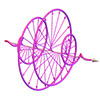| Oct 26, 2021 |
|
(Nanowerk News) Terahertz radiation, between infrared and microwave radiation in the electromagnetic spectrum, possesses unique advantages for fundamental studies and practical applications. The ability to generate and manipulate broadband chiral terahertz waves is essential for applications in material imaging, terahertz sensing, and medical diagnosis. It can also open up new possibilities for nonlinear terahertz spectroscopy, as well as coherent control of chiral molecules and magnetic materials, which could eventually enable new drug development and fast data storage.
|
|
Producing and controlling circularly polarized coherent terahertz waves can be accomplished in a variety of ways. There are three kinds of methods currently in use: (1) direct generation from gas plasmas, by applying external fields or a combined two-color laser scheme; (2) special frequency-conversion techniques in nonlinear crystals and in magnetic and novel topological materials; and (3) implementation of passive optical components.
|
|
These methods commonly suffer from low efficiency, narrow bandwidth, or poor flexibility. A high-performance, flexible, and economical solution for generating and manipulating broadband, circularly polarized, and coherent waves in the terahertz regime is still in demand.
|
|
Recently, novel spintronic terahertz emitters have attracted attention as low-cost, highly reliable, efficient, and flexible options. These emitters are composed of magnetic multilayer heterostructures only a few nanometers thick. Under an external magnetic field and laser illumination, a longitudinal spin flow is excited in a ferromagnetic material layer. Then, thanks to strong interaction between spins and orbitals in a nonmagnetic layer, the spin flow is converted to a transverse charge current, which gives rise to coherent terahertz-wave radiation.
|
|
The established micro-nano fabrication of thin metallic films allows these spintronic emitters to be processed into metasurfaces, which opens up great potential for applications.
|
 |
| Schematic of the generation of chiral terahertz waveforms from a stripe-patterned spintronic-metasurface terahertz emitter under an external magnetic field.
|
|
As reported in Advanced Photonics (“Active spintronic-metasurface terahertz emitters with tunable chirality”), researchers from Fudan University recently proposed and developed a novel spintronic-metasurface terahertz emitter that allows the generation and manipulation of chiral terahertz waves in an efficient and highly flexible manner.
|
|
The emitter is composed of alternating magnetic heterostructures arranged in multilayer stripes. The terahertz radiation is generated by exciting the emitter with laser pulses under an oriented external magnetic field. The transverse anisotropic confinement of the laser-induced charge currents imposed by the metasurface structure leads to chiral terahertz-wave emission.
|
|
The researchers demonstrated that an excellent circular polarization (ε>0.75) can be realized over a broad terahertz bandwidth (1 – 5 THz), with generation efficiency comparable to commercially available nonlinear crystals. The design also allows flexible manipulation of the terahertz polarization state and helicity with the magnetic field. The hybrid terahertz emitters combine the advantages of spintronic emitters (ultrabroadband, efficient, and highly flexible) with those of metasurfaces, for powerful control over the polarization state of emitted terahertz waves on an ultracompact platform.
|
|
According to Zhensheng Tao of Fudan University’s State Key Laboratory of Surface Physics, “This work opens a new pathway to metasurface-tailored spintronic emitters for efficient generation and control of terahertz waves. The combination of ultrabroadband, efficient spintronic emitters, and metasurfaces with predesigned functionality, could lead to many more types of emitting devices for different spatial and temporal terahertz waveforms.” Tao notes that this technological advance may eventually lead to arbitrary field design of a terahertz wave with subcycle precision in both space and time.
|


